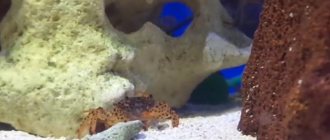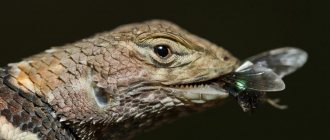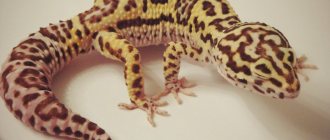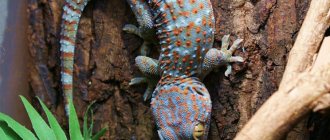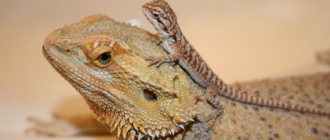Share this article:
We are all familiar with cute, nimble creatures called nimble lizards. They are very widespread and are found in steppes, forests and even mountains. Few people as a child did not dream of taking such a “little animal” to their home. Is it possible to keep them at home and what is required for this? Let’s find out.
Sandy lizard in nature
Lacerta agilis Linnaeus (this is its Latin name) inhabits large territories in Russia, limited by South Karelia, the south of the Arkhangelsk region, the Komi Republic, the Khanty-Mansi Autonomous Okrug, and Western Baikal region.
It is no less widespread in other countries: Southern England, Eastern France, the Baltics, Belarus, Ukraine, Georgia, Armenia, Azerbaijan, Kazakhstan, etc.
The lizard prefers dry, sun-warmed places in the forest, steppe or mountains no more than 1.5 km high. Reptiles live in pairs. At night they hide under stones, stumps or in burrows. They most often winter there.
Plant food for lizards
About a third of the lizard's diet consists of plant foods. You can offer your pet greens - lettuce, parsley, plantain, spinach, clover, dandelion, etc. Reptiles also eat pieces of vegetables well - cabbage, broccoli, zucchini, cucumbers, carrots, and sometimes raw potatoes can be given. Fruits you can give are apples, pears, melons, grapes, citrus fruits - experimentally you can find out which ones your pet likes best.
Vitamin and mineral supplements can be mixed into food: for example, added to fruit or porridge with insects. It is also useful for the lizard to give crushed eggshells, calcium glycerophosphate tablets, chalk, and preparations for reptiles.
What does a sand lizard look like?
Its length is 25-28 cm. In appearance, these representatives of the family of true lizards are similar to tailed amphibians, but differ from them in a more slender body.
- The head is pointed towards the muzzle. At the end of the latter there are two nostrils.
- The neck is short and thick.
- The eyes have eyelids, as well as a third eyelid - a special nictitating membrane to moisturize the eye.
- Behind the organs of vision you can see rounded eardrums. The sand lizard has excellent hearing.
- The organ of touch is the tongue: long, thin, forked at the end. Periodically, the lizard sticks it out of its mouth, exploring the surfaces.
The limbs of a lizard resemble those of a frog. All feet have five unwebbed toes, with claws necessary for climbing. The skin is dry, with horny scales. On the muzzle and abdomen they are larger and more like large scutes. As lizards grow, they molt. This happens about once every 4-5 years. Breathing is only pulmonary, no skin breathing.
There are a lot of color options for males (from light green and olive to almost black). In the southern regions green predominates. During the breeding season, males become brighter. Females are gray or brown with a variety of patterns. Juveniles are the same color, but with three stripes on the back.
What to feed your pet lizard
And now, the most interesting question is what to feed your pet lizard, given that it eats several times a day? Well, you can offer your reptile various insects - spiders (only non-poisonous ones), crickets, mealworms... Some give small reptiles or bird eggs. However, if the lizard is small in size, then it is better to protect it from eating mammals. This is fraught with indigestion and can lead to illness and death of the reptile.
You can also prepare a nutritional mixture for your favorite lizard. According to those who have such a pet in their house, lizards simply adore it.
How to prepare a nutritional mixture for a lizard
Take carrots and meat in equal proportions (although some owners are categorically against giving meat to lizards - they prefer to replace it with insects, larvae and other living creatures, but grinding meat is much more aesthetically pleasing than passing earthworms through a meat grinder), and skip it all through a meat grinder (carrots can be grated), then add some lettuce leaves, vitamin supplements, and calcium to the resulting mixture. The lizard will definitely like this dish, and she will willingly eat it for breakfast and lunch, but for dinner she will have to be offered something else. By the way, it is recommended to feed young lizards using long tweezers, but older ones can put food in a bowl.
Also remember to wash your hands thoroughly with soap after feeding your lizard. So, just in case...
What to do if your lizard refuses to eat
Group lunch
This question is very often asked by reptile owners who are not yet accustomed to their status as a lizard breeder. Well, perhaps you just simply overfed your pet, and he decided to arrange a couple of fasting days for himself. Just watch the lizard's behavior - if it is still active, drinks water well, but simply refuses food or eats very little - it's not scary. The reptile may thus relieve its body from your overfeeding (a symptom of the latter is frequent belching), or perhaps it is clearly hinting to you that what you are feeding it is not to its taste. In this case, it is recommended to reconsider the diet of your pet or pet.
It is not uncommon for young lizards to refuse to feed themselves. In this situation, you can try to interest the reptile in breakfast or lunch in the following way - squeeze out the contents of the mealworm and lubricate the lizard's mouth with it. She will definitely lick it off, and then, having tasted the delicacy, will greedily reach for food.
Does a lizard need vitamins?
If you want your reptile to be healthy, look bright, and behave lively, it must include vitamins and minerals in its diet. If you have a vegetarian lizard, you can crush these vitamins and minerals and mix them with rice and fruit. For predator lizards, you can prepare a mixture of food insects and add vitamin powder to it. Some owners even specifically inject mice and rats with vitamins before giving them to their lizard to eat, or inject the latter with minerals in gelatin capsules. To do this or take a simpler path - each owner must decide for himself. The main thing is to avoid substances that may discourage your pet from eating or spoil his appetite...
By the way, calcium can be given to lizards in the form of cuttlefish shells or in the form of crushed eggshells (the eggs must be raw).
Does a lizard need water?
Of course. Make sure that in the terrarium, in a special drinking bowl or some other stable container (so that the lizard cannot turn it over) there is always fresh and clean water, which you will need to change daily. Without water, the reptile may die.
Character and compatibility of the sand lizard
They use burrows dug by themselves or other animals as housing. They do not go far from them, a maximum of 10-15 meters, even during hunting. In case of danger, they run away, disorienting the enemy by frequently changing the direction of movement.
Daytime activity. These lizards are very nimble: they run fast, climb high, jump well, can change the direction of movement with lightning speed, catch flies in flight, etc. For these “talents” they are called nimble.
At the same time, they are very careful, constantly on the alert. In case of any danger, they rush into a hole or climb onto a plant branch. If the pursuer grabs the lizard by the tail, it can save its life by throwing away part of it. In response to pain (and not to mechanical tension), a fracture occurs in the middle of one of the vertebrae. There is never any bleeding due to muscle contraction around the wound.
In the future, the tail will regenerate, that is, it will grow back, but it will be a little shorter and a slightly different color. It's a reflex.
Content Features
Most often, the quick lizard lives in Russian latitudes, which later becomes a pet for exotic lovers. And in order for her to feel comfortable outside of natural conditions, it is necessary to provide her with a comfortable living environment.
Location. You can choose any shape of the terrarium, but the size must be at least twice the length of the animal’s body. And if the size of the room in which the “housing” will be located allows you to purchase a larger “house,” then the pet will only be happy. It will be necessary to pour soil at the bottom, but it is best to take it in a forest or steppe so that the soil does not contain any foreign additives. Bark or special mats that can be found in pet stores are also suitable.
Since in nature these reptiles actively climb trees thanks to their tenacious paws, it would not be amiss to install several branches in the aquarium, as well as to bring the “interior” as close as possible to the natural one with the help of stones and plants.
Temperature. Everything is a little more complicated here, but don’t worry, all the necessary equipment is on sale that will help create a comfortable atmosphere for your pet. The lizard needs two temperature zones - one is very warm, with a temperature of +35 degrees, the second is cooler, up to +30. At night the temperature can drop to +20.
Light. Remember that lizards live in warm latitudes and spend most of their time in the sun, so light is vital for them. To do this, it is advisable to install a regular lamp and an ultraviolet lamp.
Humidity
This characteristic also needs to be paid special attention. The optimal humidity level is 50-70%
To achieve this, simply place a container of water in the terrarium. In addition to the fact that by evaporating the water will contribute to the formation of the required level of humidity, the lizard will be able to perform water procedures there. For the same purpose, you can spray the plants and branches inside with a spray bottle. But the main thing is not to overdo it; too high a moisture level can cause the development of fungus and the death of the reptile.
Nutrition. What do they feed lizards? In the warm season, the feeding regimen should be three times a day, and in winter two meals a day will be enough. Typically, such animals feed on flies, spiders, and crickets. Food made from grated carrots, fresh meat, lettuce and vitamin supplements will also be useful.
Small pets will need to be fed with tweezers, adults do not need this and can eat on their own.
Reproduction. At home, lizards can reproduce. But this can only be done when the female reaches 2 years of age, and in the cold season, when the activity of reptiles is quite low. After mating, the female needs to be transplanted into a separate terrarium, having previously prepared a place for burying the eggs (you can use peat and moss). As soon as the small lizards hatch, they also need to be replanted, and monitor the temperature (about +40+42 degrees) and humidity (spraying the terrarium 2-3 times a day).
Small, quick and active lizards will make excellent pets. Despite their predatory nature, they live well in the home and delight their owners.
How to prepare an animal for keeping in a home terrarium
Preparation consists of three stages:
- Carefully examine the reptile's body for the presence of skin parasites. Most often these are ticks that are brightly colored and therefore visible even to the naked eye. These parasites are not dangerous for humans, but they cause a lot of inconvenience to the lizard itself and can even lead to its death.
- Quarantine for 2-3 weeks.
- Deworming using special anthelmintics for reptiles.
New pet at home - what to do
Even a beginner understands that a lizard is not the most common pet, and it requires special care. What to do if such living creatures appear in the house?
- First of all, you should examine the lizard for parasites - often mites settle on their skin, which are easily detected due to their bright coloring. As a rule, such parasites do not pose a danger to people, but they cause discomfort in the lizard and can even cause its death.
- The pet should be placed in a quarantine tank for 14-21 days.
- It is recommended to carry out deworming using special products intended for reptiles.
How to set up a terrarium
Dimensions . A container of 40 by 60 by 40 cm will be sufficient for maintenance. The door should be on the side, not on the top. Then the lizard will see that it is not being attacked and will experience less stress. It is acceptable to keep it in a spacious, low aquarium without a lid. But never in any boxes!
Microclimate . Air temperature monitoring must be carried out, including at night. It is better to create two temperature zones: hot (36 °C) and cool (up to 30 °C).
Night temperature should not be less than 21 °C. Otherwise, the lizards’ metabolism slows down, they become lethargic or even go into hibernation.
There are various devices available to maintain the correct temperature. You can buy them at pet stores. The following are used in terrariums:
- Lamps (incandescent, mirror, fluorescent, halogen, mercury).
- Thermal stone. This is an artificial stone that, when turned on, simultaneously creates bottom heating and decorates the terrarium. Negative point: may heat up above the stated temperature.
- Thermal cord. Also used for bottom heating. Place under or inside the terrarium. Using the thickness of the soil, you can create different heating points.
- Thermal mat. Used in the same way as a thermal cord.
Sunlight . Install a UV lamp marked 10-12%. It must work around the clock and be replaced every six months. Without ultraviolet light, calcium and vitamin D are poorly absorbed, the reptile’s bones begin to deteriorate, and it dies a painful death.
Humidity control . The terrarium must have a bowl of water of such a size that the lizard can climb into it. It is located in a cool area. Additionally, you can spray or use damp sponges. It is also recommended to avoid overwatering, as fungus will appear. To do this, ventilation in the home must be good.
You can also install a wet chamber in the terrarium, into which the lizard will climb as needed. It can be made from a plastic container, with a hole cut out on the side of which the animal can fit through. Coconut substrate or paper napkins are poured onto the bottom of the chamber. The soil in the container must be periodically moistened, maintaining moderate humidity.
Decor . Equip several shelters and a pond. All decor should not have sharp edges so that the lizard does not get hurt. You can place several branches for climbing.
at the bottom of the terrarium, except for small shavings, sand, etc. They can get into the gastrointestinal tract with food and cause problems.
Making a terrarium with your own hands
An aquarium can serve as a home for a pet. But you can do it yourself without much difficulty. The best material is organic glass. If the apartment contains a small lizard, the house for it is made without a frame. For a large individual, it is a frame structure. So, how to make a terrarium for a lizard? Below are the instructions:
- First the frame is made. It is easy to make by connecting the bottom and walls with silicone glue, which does not pose a danger to animals.
- Then you should start arranging ventilation. To do this, holes are drilled on one wall. You can make a wall out of wire. It will serve as a ventilation duct and active lizards can crawl along it.
- Next you should start making the bottom. For this, plywood made of several layers is better suited.
- The lid remains. It is better to make it from a fine metal mesh. Through it you can clearly see the interior of the terrarium, and most importantly, air circulates. You can make a composite cover. Its glass part is attached hermetically, and the wire part is folded back.
Feeding the sand lizard
In nature, these reptiles feed on beetles, grasshoppers, earthworms, caterpillars and spiders. That is why the diet must include live food. You can catch it yourself, but in this case the insects may be infected with parasites.
You can find crickets and cockroaches in pet stores. It’s a good idea to feed mealworms, tobacco hawkmoth, and locusts.
Occasionally it is allowed to serve meat (raw beef or boiled chicken) and eggs. If the pieces are large, the lizard will chew them in its mouth for a long time, spitting them out and swallowing them again.
Food should not be monotonous. For example, if you feed only mealworms, this is fraught with fatty liver in the lizard.
Special mineral and vitamin supplements should be given regularly. They are available in powder form.
Feed is given daily, 3 times a day in summer and twice in winter, in the amount of 5-10 insects per meal. Adult lizards can take food on their own, but juveniles are recommended to give it with tweezers. It is better to remove uneaten insects from the terrarium at night. There are cases where grasshoppers and crickets damaged the skin of a sleeping lizard.
Carnivores or meat eaters
The following food is suitable as food for this species:
- Insects;
- worms;
- fish;
- cockroaches;
- snails
This species is very picky about food and feeding it at home will not cause any difficulties. But the cost of food will be directly dependent on the quality of food and the size of the reptile. The main food source should be insects, flies, locusts, worms, grasshoppers and cockroaches.
If the size of the lizard requires larger food, then you can sometimes treat it with small mice, rats or frogs. Before feeding such food, it is recommended to give rodents an injection containing vitamins and calcium. Thus, the reptile’s body will be additionally enriched with calcium after it eats this rat or small mouse.
You can offer simple meat or fish from time to time. But in this case, be careful
Before you give your lizard a treat, it is important to make sure that there are no parasites in the food. If you do not follow this rule, there is a high risk of infecting your reptile with intestinal disease.
Stick to the fact that everything should be in optimal quantities. Don't give too much meat or fish. And before giving such food, it is necessary to remove cartilage from meat and remove bones from fish.
Snails are the best food option for reptiles at home. It is very easy to breed this food. And thanks to the saturation of snail shells with calcium, this product is simply irreplaceable for almost all types of lizards.
It is not without reason that the diet recommended by veterinarians contains various sources of calcium: cuttlefish shells, egg shells and others.
Is wintering in captivity necessary?
Not all breeders hibernate their lizards, but it is still very important. What does it affect:
- For reproduction. Lizards that do not hibernate do not mate.
- On the brightness of the color of males. “Non-sleeping” males fade over the winter and their color does not return in the spring.
- On the activity of the animal.
- For lifespan. Without hibernation, they get sick more often and live less.
Temperature maintenance
The owner needs to take care of the microclimate - he should equip the lizard’s home with a thermometer and monitor the indicators, even at night. It is advisable to equip the tank in such a way that it has 2 zones - hot (34°-36°C) and cold (not lower than 30°C). At night, the thermometer should not fall below +21°C, otherwise the animal’s metabolic processes slow down, activity decreases, and some individuals begin to prepare for hibernation.
To maintain the temperature, it is best to use special devices that can be purchased at any pet store. The following devices are suitable for terrariums:
- lamps - they come in a variety of varieties: mirror, incandescent, halogen, etc.;
- Thermal stones are artificial minerals that, when turned on, heat the tank and are an excellent decoration for it. There is only one drawback - they can heat up to higher levels than stated;
- thermal cords - they are used to heat the lower part of the terrarium, stretching under containers or inside;
- thermal mats - used in the same way as the previous device.
How to hibernate a lizard and bring it out of it?
- A month before the planned hibernation, you should strengthen and diversify your diet. (This does not apply to individuals whose weight is normal.)
- After this period, the lizard does not need to be fed for a week to cleanse the intestines.
- Next, gradually or stepwise (5 degrees at a time) begin to reduce the temperature in the terrarium. Each “step” should take from 3 to 7 hours.
- The final temperature for hibernation is +5, +7.
A temperature-controlled refrigerator is suitable for wintering. There is no need to place the entire terrarium there. It is enough to place the lizard in a container with holes for air.
It is important to know that a hibernating lizard breathes about 2 times per minute, and the heartbeat is practically not felt. For there were cases when owners threw out live lizards, mistakenly considering them dead.
- Coming out of hibernation begins with a gradual increase in temperature.
- Next, you will need to provide UV irradiation and good heating.
- For the first three days, the lizard can only warm itself and not eat anything.
- You should not force feed her.
- If the outcome is successful, the lizard will soon become active again and shed.
Hibernation should last no less than one and no more than four months. Why exactly these deadlines?
- If wintering lasts less than a month, then it is not enough and problems arise similar to those in the absence of hibernation at all.
- If the lizard “sleeps” beyond the specified period, then it does not have enough energy and substances, exhaustion begins, and it dies during hibernation or upon emerging from it.
Terrarium for a land monitor lizard
To provide your pet with comfortable living conditions, you will have to buy a terrarium for it. It is better to choose horizontal models with dimensions of at least 120x60x50 cm.
They must be equipped with heating, for which special thermal mats, thermal cords or heating lamps are used. During periods of activity of an exotic pet, it is necessary to heat it in this way during the day, about 12 hours
It is also important to install ultraviolet lamps, which should work all day long (even if it seems to you that the lizard has enough natural light). At night, the air temperature in the terrarium should not exceed 20 degrees, and during the day – 28
What health problems can a sand lizard have?
Most often there are two of them:
- Binge eating . Leads to decreased activity, illness, shortened life, and problems with reproduction.
Signs of overeating: the animal hardly eats, lies a lot and moves little, does not shed, and its belly has become enlarged. Under no circumstances should the problem be solved simply by not giving food! It is necessary to gradually reduce its amount, while simultaneously increasing daylight hours and heating. All these measures should speed up metabolic processes and normalize the condition.
- Malnutrition . Fasting for 2-4 weeks without hibernation is considered harmful.
In this case, the body is depleted, metabolism is disrupted, growth slows down, color deteriorates, problems with reproduction, molting and hibernation occur. Malnutrition can be determined by thinness, sagging skin, a shriveled tail, very increased or, conversely, decreased activity, and aggressiveness towards everything.
You cannot give such animals a lot of food at once! You need to start with 1-2 nutritious insects, very gradually increasing the portion to normal. At the same time, increase daylight hours and heating, as well as humidity. It is important to know that after a long fast, the process of digesting food takes twice as long as before.
Advice: if you need to leave for 1-2 weeks and leave the lizard at home, then you should reduce the temperature in the terrarium to 15-20 degrees and turn off the lighting.
In this case, activity will remain, but metabolic processes will slow down, due to which energy and nutrient reserves will begin to be consumed more slowly. Don't forget to leave water too!
Microclimate
The animal feels normal at room temperature, but if a representative of one of the southern subspecies lives in the terrarium, then the temperature should be maintained within the range of +25 to +30 degrees during the day and from +18 to +20 degrees at night.
The temperature regime can be ensured either with a thermal mat or with an ordinary incandescent lamp with a reflector. But in this case, the lamp should be located out of reach of the animal.
Humidity should be maintained at least 75–80%, which is achieved by regularly spraying the interior of the terrarium.
To organize feeding, you need to install a food cup and drinking bowl. Over time, the lizard gets used to one place for eating and drinking.
Reproduction of the sand lizard
The male, ready for reproduction, raises his body above the ground and looks around. Seeing a female, he chases her. If he manages to catch it, he grabs it with his mouth at the base of the tail, clasps it with his paws and mates.
After some time (usually the end of May), the female lays from 6 to 16 fairly large eggs and buries them in a shallow hole. The embryo develops inside the egg, and a ready-made young lizard emerges (in July). Seasoned males can eat small lizards.
In conclusion, it only remains to say that despite their exoticism, quick lizards are rather unpretentious creatures. The main thing is to create the “right” conditions for them from the very beginning. They are also cute and smart. Watching them is a pleasure for both children and adults.
Domestic lizards: maintenance features
Currently, there is a great demand for keeping lizards at home. It is worth noting that in captivity these reptiles reproduce very well, and the survival rate of offspring is more than 70%. It is quite difficult to distinguish a male lizard from a female. The main differences appear only after puberty:
- males of some species are distinguished by a bright dorsal crest, which increases as the individual grows older;
- male lizards quite often have sharp spurs on their paws;
- many species have large throat sacs.
All these signs cannot give a 100% guarantee in determining the sex, so if you plan to breed lizards, then determine the sex of the individual using a blood test at a veterinary clinic.
In the wild, the daily diet of lizards is very varied. This predator prefers to hunt at dawn or after sunset. Food most often consists of insects, worms and shellfish. Large species can feed on other reptiles, bird eggs and small birds. Some lizards are vegetarians and eat only plants and fruits. At home, it is necessary to maintain a variety of daily food, although the lizard's diet may consist of the simplest foods:
- insects (worms, spiders, etc.);
- raw eggs;
- raw finely chopped meat;
- vitamin mixture of boiled chicken, grated carrots and lettuce leaves;
- specialized supplements from pet stores.
You can feed the lizard three times a day during the hot season, and twice during the winter season. Despite the fact that the climate in the terrarium remains warm, the lizard senses the change of season and significantly reduces its activity.
Lizards reproduce well in captivity. The mating season begins in the spring and lasts several months. Large lizards give birth only once a year; small species can breed two or three times per season. In nature, males always compete for a female, with the winner getting the opportunity to mate. In captivity, it is enough to place the pair in one terrarium and leave them alone for several days. During this period, lizards may refuse to eat, but clean water should always be within reach.
Lizards can lay eggs or give birth to offspring already adapted to life. On average, lizards lay about ten eggs and hide them away from prying eyes - in the sand or behind rocks. The eggs remain in this state for up to forty-five days. The hatched cubs are almost completely independent. Viviparous species of lizards carry their young for up to three months. On average, the lifespan of an adult is no more than five years.
Other indicators for pet comfort
Stable temperature is not the only requirement for living conditions for a lizard:
- Ultraviolet rays - the pet needs sunlight, for this it is recommended to equip the terrarium with a UV lamp (5% marking). It must be turned on constantly and replaced every 6 months. If there is a deficiency of ultraviolet radiation, the animal’s body cannot fully absorb calcium, bone tissue is destroyed, and the pet dies in agony.
- Humidity control – it is recommended to install a small reservoir of water in the lizard’s home, into which it can climb on its own, and it is placed in a cool area. In addition, you can spray the interior surfaces of the terrarium daily or use moistened sponges. It is important to avoid excessive humidity, as fungi often grow in such conditions. You can avoid such a nuisance by ensuring good ventilation.
- Decor - the pet needs shelter and a pond, you can also mark twigs and snags on which the lizard will climb.
- Soil - it is placed at the bottom of the tank; any material intended for these purposes can be used. Only small shavings and sand are not suitable, as they can penetrate with food into the animal’s gastrointestinal tract and provoke various kinds of problems.
Where do lizards live?
Various species of lizards live on all continents except Antarctica. Representatives of reptiles familiar to Russia are real lizards that live almost everywhere: they can be found in fields, forests, steppes, gardens, mountains, deserts, near rivers and lakes. All types of lizards move well on any surface, firmly clinging to all kinds of bulges and irregularities. Rock species of lizards are excellent jumpers; the jump height of these mountain inhabitants reaches 4 meters.
Large predators, such as monitor lizards, hunt small animals - their own kind, and also happily eat the eggs of birds and reptiles. The Komodo dragon, the largest lizard in the world, attacks wild boar and even buffalo and deer. The moloch lizard feeds exclusively, while the pink-tongued skink eats only terrestrial mollusks. Some large iguanas and skink lizards are almost entirely vegetarian, their menu consisting of ripe fruits, leaves, flowers and pollen. Lizards in nature are extremely careful and agile; they approach their intended prey furtively, and then attack with a swift dash and capture the prey in their mouths.
Komodo monitor lizard eating buffalo
Peculiarities of reproduction of agile lizards
First of all, by looking at the male, you can find out about his readiness to mate. He lifts his body off the ground and begins to look around, looking for a potential “bride.” Having discovered a suitable individual, he pursues it. If the “race” is completed successfully, and the female falls into his arms, he, holding the base of her tail with his mouth and her body with his paws, begins to mate.
After some time, the female lays a clutch, burying 6-16 fairly large eggs in a small hole. All stages of the development of the offspring occur in the egg, and an independent young individual is born. Particularly large and confident males are capable of eating young.
Sandy lizards are perfectly adapted to living in the natural environment, which confirms their wide distribution and the presence of numerous populations. However, in order for such a pet to feel comfortable in captivity, the owner needs to try. Of course, these inhabitants are not too whimsical compared to other lizards and amphibians, but they need suitable conditions.
All the efforts made will pay off with interest - active and agile lizards will delight children and adults with their liveliness, interesting behavior and charisma. It is almost impossible to pass by the terrarium where this animal lives and not stop.
Herbivores or herbivores
The main type of food for this type of lizard is various fruits and vegetables, for example:
- Grape;
- carrot;
- cabbage;
- apples;
- lettuce leaves;
- potato.
However, it is allowed to give these products in mixed form. But when feeding potatoes, be careful, as this product contains many different nitrates. Before treating your pet, peel the skin of such food and cut into small pieces.
When eating food occurs, carefully watch the lizard and try to understand its taste preferences. Subsequently, it will be possible to take into account her tastes when thinking through her diet.
, offer every two weeks . Predators need to be given plant foods.


